Who is Mykhailo Boychuk, whose academy was damaged by a Russian missile
[ad_1]
As a result of the Russian shelling of the capital on March 25, a fragment of a rocket destroyed part of it building of the Mykhailo Boychuk Academy of Decorative and Applied Arts and Design on Mykhailo Boychuk Street.
The Academy was named after Boychuk in 1999. Mykola Rokytskyi, one of the few students of Boychuk who managed to avoid being shot, was also involved in the establishment and development of the institution. The Academy itself adheres to the principles that Boychuk followed – research and reproduction of traditions based on modern challenges.
Mykhailo Boychuk is one of the brightest representatives of Ukrainian modernism. And at the same time – one of the least known and researched: at the end of the 1930s, the Soviet authorities shot Boychuk himself, his wife, and almost all of his students, and destroyed the artistic output of the Boychukists. After more than 80 years, the heiress of Soviet terror, Russia, returns to destroy the institution bearing his name.
Art columnist UP Culture Olga Dudenko together with the head of the department of museum affairs of the Art Arsenal Olga Melnyk tells about Mykhailo Boichuk – a Ukrainian artist who founded his own school, studied in Munich, Krakow, Paris and had a considerable number of followers.
The hope of young Ukrainian art
It was quite a challenge – to assemble a large project in the Art Arsenal from the scattered fragments of the artistic heritage of the Boychukists, he recalls Olga Melnyk. 2017, together with his colleagues Igor Oksametny and Victoria Velichko they researched the works of Mykhailo Boychuk and his followers in the collections of Ukrainian museums and created a large-scale exhibition about the unique phenomenon of Ukrainian modernism “Boychukism. A project of great style”.
The exhibition “Boychukism. A project of great style”
Evgeny Nikiforov
This phenomenon originates in the village of Romanivtsi in the Ternopil Oblast, which was then part of the Austro-Hungarian Empire. Mykhailo Boychuk was born there on October 30, 1882. Mykhailo was the firstborn in a large family – there were nine children in total.
Mykhailo’s early drawings were lost in the fire of the house that burned down during the First World War. However, the boy’s talent was noticed at school, and the teacher began to look for a painter-mentor for him.
Boychuk’s teacher was Julian Pankevich, an artist who was engaged in religious painting. And where does the monumentalism that Boychuk researchers trace in all his works originate. Pankevich took the sixteen-year-old to Lviv and arranged for him to study in his studio.
In Lviv, young Mykhailo’s talent was also quickly noticed. Mykhailo Hrushevsky, who was the head of the Scientific Society named after Shevchenko (NTSh) since 1897, together with his colleagues financially contributed to Boychuk’s education.
In 1899, Mykhailo was enrolled in a private drawing school in Vienna. Subsequently, on a scholarship from the National Academy of Sciences and the recommendation of Ivan Trush, Boychuk entered the Krakow Academy of Arts, which he graduated with a silver medal.
The next city was Munich, where Mykhailo Boychuk studied under Franz Herterich and Franz von Stuck – the masters of Wassily Kandinsky and Paul Klee. In the break between studies in Krakow and Munich, the artist participated in the First All-Ukrainian Art Exhibition of 1905 in Lviv, exhibiting his own portraits.
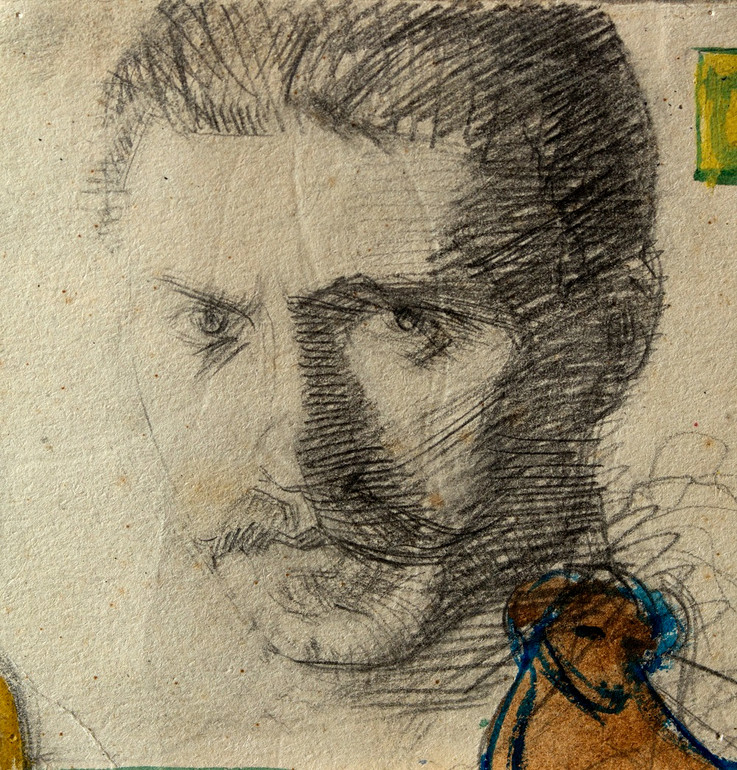
Mykhailo Boychuk. Self portrait. Start 1910s, paper, pencil
Lviv National Art Gallery named after Boris Voznytskyi
Thanks to the support of Andrey Sheptytskyi, Mykhailo Boychuk goes to Paris – at that time the center of European artistic life. He gets acquainted with the work of Paul Cézanne, Pierre-Auguste Renoir and Pablo Picasso.
French artists attract Boychuk with a combination of national ideas and modern artistic styles, which Mykhailo will use when founding the school of Boychukists. It is the Parisian salons, where artists collaborate, that become the model of work that inspires Boychuk to build a school as opposed to the individual education of artists.
Researcher Olga Melnyk calls this time “the period of accumulation of artistic experience”:
“Obviously, staying in Europe became a kind of inoculation of values and ideas. In Kraków, where Boichuk became close to the followers of the concept of national revival, he had the idea of creating a Ukrainian style. Boychuk mastered artistic techniques in Munich. Here he also got acquainted with formal searches that were new at that time, in particular, the synthesis of architecture and applied arts.”.
Boychukist style
In his work “Avant-garde Art 1910-1930 in Ukraine”, Myroslav Shkandrii described Boychuk’s style as follows:
“Boichuk was looking for epic, monumental images that represent princely past of Ukraine (which suggests lost statehood and greatness), alternate with images of the peasantry (in the sense of the eternal world of nature) and idealized symbols (for example, archetypes of devotion, mercy and diligence). The goal was to form the concept of general and universal Ukrainianness, which had its own past, present and future.”.
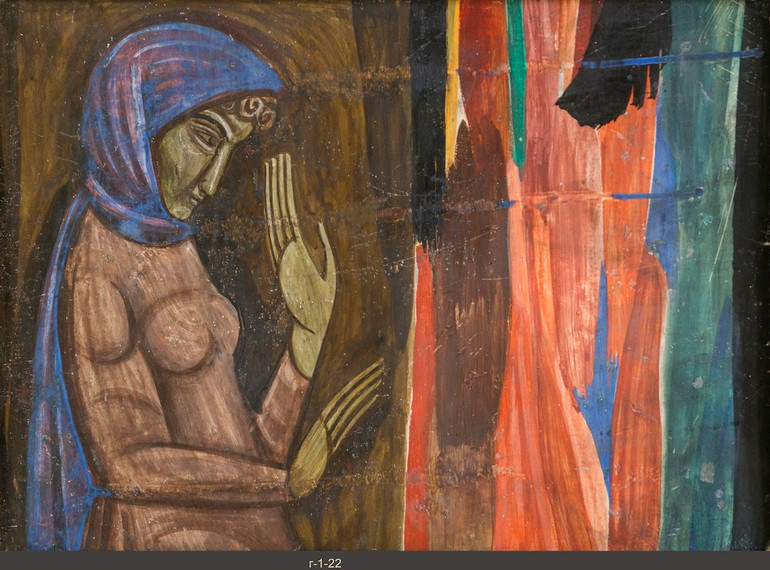
Mykhailo Boychuk. The girl in front of the tree. 1910s. Cardboard, tempera
Lviv National Art Gallery named after Boris Voznytskyi
That is why Boychukism is sometimes called neo-Byzantism. Mykhailo saw the revival of new Ukrainian art in Byzantine ideas, and the decisive factor for this was the combination of traditions, appeal to ancient Russian icons, paintings of the Italian Renaissance, and modernist ideas.
Olga Melnyk comments on the contemporary confrontation between Boychukism and avant-gardeism:
“It was in Paris that the dispute between the Boychukists and the avant-gardes, which will continue for the following years, began – Guillaume Apollinaire spoke quite ironically about the work of the neo-Byzantines. Oleksandr Arkhipenko, another Ukrainian Parisian at the time, considered their method dead-end. It is interesting that sometimes Boychukism is classified as avant-garde trends. However, this is not a completely correct statement, because the avant-garde undeniably rejects the artistic tradition.”
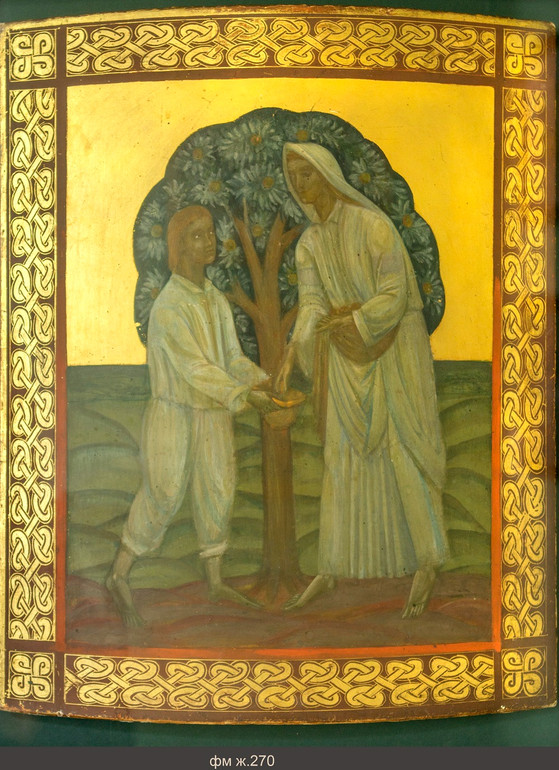
Mykhailo Boychuk. Under the apple tree. 1912-1913. Wood, tempera. gilding
Lviv National Art Gallery named after Boris Voznytskyi
They became the first followers of the artist’s ideas Mykola Kasperovych, Sophia Beaudoin de Courtenay, Sophia Nalepinska. Mykhailo will marry the latter in 1911. Shkandriy says that the Lviv community had high hopes for Boychuk: “He was seen as a chosen son, called to create modern art”.
Variety of creativity
After the revolution of 1917, Mykhailo Boychuk moved to Kyiv to be at the epicenter of the national revival. In the same year, he was invited to lead the workshop of monumental painting at the Ukrainian Academy of Arts, established by the Central Rada. There Boychuk works side by side with Fyodor and Vasyl Krychevskyi, Oleksandr Murashko, Mykhailo Zhuk, Georgy Narbut, Abram Manevich.
“Here he was finally going to realize his creative ideas. To begin with, he had to raise a universal artist who would introduce synthetic artistic forms into everyday life for the sake of the public good. This was a fairly widespread idea in Europe, which, by the way, Walter Gropius, the founder of the famous Bauhaus, professed.”– says Olga Melnyk.
In the capital, the artist is working on the restoration of the frescoes of St. Sophia and Assumption Cathedrals. Boychuk returns to restoration in Chernihiv as well, restoring the Yeletsky Monastery. In addition, Metropolitan Sheptytskyi ordered a series of paintings from the artist for the chapel of the Holy Spirit of Dyakivska Bursa in Lviv.
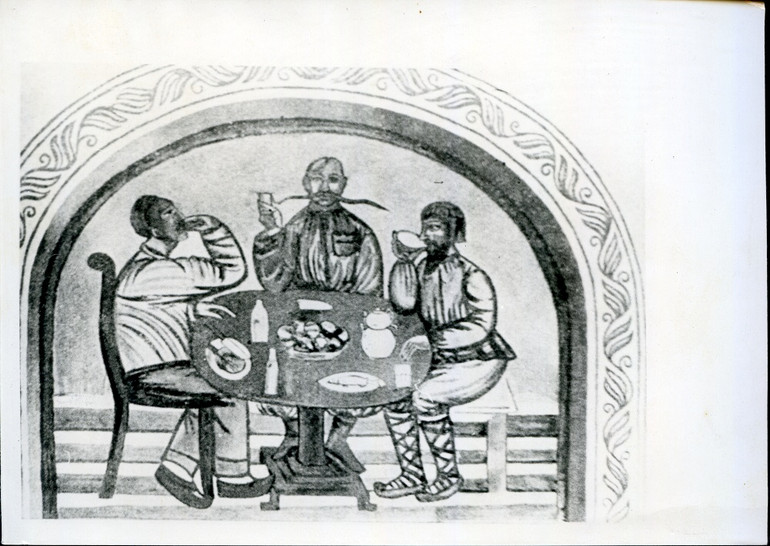
A fragment of a painting of the Lutsk barracks in Kyiv. 1919
Central State Archive-Museum of Literature and Art of Ukraine
Together with Ivan Padalka and Vasyl Sedlyar, Mykhailo’s closest followers, they painted Lutsk barracks in Kyiv (1919), VUCVK sanatorium in Odesa (1928), Chervonozavod theater in Kharkiv (1933-1935). According to Olga Melnyk, “Boichuk did not teach, but directed students, further developing collective creativity. The teacher and students did everything together – they studied and copied the works of old masters, and in times of famine they moved to the residence of Boychuk himself on Tatarka. Paintings of the Lutsk barracks on Degtyarivka are the first joint work of the Boychukists. Sometimes it is impossible to determine the authorship of such works, because several artists contributed to their creation at once.”.
Another guise of Boichuk was the development of theatrical scenery for productions in Kyiv’s “Young Theater” by Les Kurbas – “Yol” by Jerzy Zhulavskyi and “Black Panther and White Bear” by Volodymyr Vinnichenko.
Portraits and self-portraits are especially expressive among Boichuk’s works. Among them are the faces of brother Tymko Boychuk, Mykhailo Hrushevskyi, Andrey Sheptytskyi, peasant women and shepherdesses.
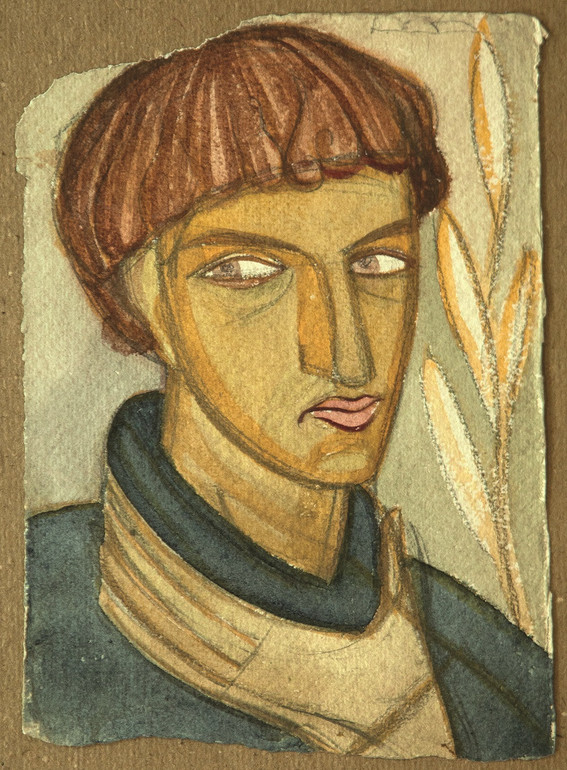
Mykhailo Boychuk. Portrait of Vasyl Sedlyar. 1927. Paper, watercolor
Art arsenal
Political posters
In the biography of Mykhailo Boychuk there is also a period of cooperation with the Soviet authorities and following the socialist realist direction. And it was not just an exchange: during the famine years, artists were able to receive food from the authorities for propaganda work. Boychukists sincerely believed in the possibility of building a new society and national style.
“After the 1917 revolution, they had a chance for national revival, and in the 1920s they hoped that this would be possible under the conditions of the Soviet system, which proclaimed very fair slogans. If we add the policy of Ukrainization with a certain liberalization, in particular of artistic practices, then the representatives of the Red Renaissance worked not for food, but for an idea. The government used them and then destroyed them.” – says the researcher.
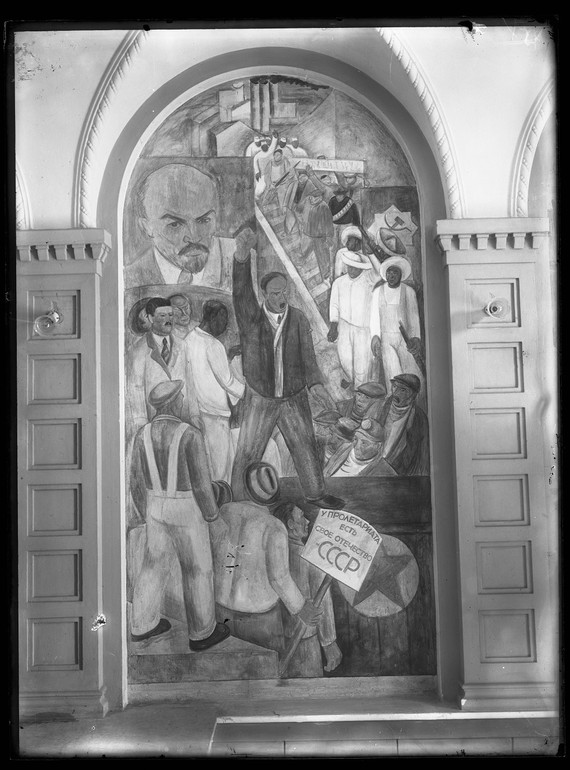
Murals in the Club of the State Political Administration in Odesa (currently KP “Obltransbud”) on the street. Marazliivska, 34a. Photos from negatives on glass.
National Art Museum of Ukraine
Among the work that Mykhailo had to do was painting campaign trains, decorating the streets during revolutionary festivals, and creating political posters. This is how images of red flags appeared, calls to Bolshevism and joining the Red Army, images of workers standing in line for mobilization.
Two of Boychuk’s posters have survived – “Shevchenko’s holiday” and “Bring gifts to the Red Army”, which today belong to the collection of the National Art Museum of Ukraine.
Repression
The pogrom of the Kyiv State Academy of Decorative and Applied Arts and Design named after Mykhailo Boychuk from the debris of a Russian rocket prompts Olga Melnyk to reflect on imperialism:
“Boichuk and his school never fit into the imperial canon. Every interaction of the artist with Russia, if it was not called the Russian Empire, the Soviet Union or the Russian Federation, whoever ruled it (Nicholas II, Stalin or Putin) ended fatally.”.

Work on a mural in the club of the village of Katarzhyn in Odesa region. 1929-1930
Central State Archive-Museum of Literature and Art of Ukraine
Mykhailo Boychuk was arrested in November 1936, accused of counter-revolutionary activities and espionage. This is not much different from the current rhetoric of Russians towards Ukrainians: NKVD employees also called Boychuk a “national fascist”.
On July 13, 1937, Mykhailo Boychuk and his students Ivan Padalka, Vasyl Sedlyar, and Ivan Lypkivskyi were shot in the Bykivnyansky forest in the Kyiv region.
Many of Boychuk’s works were covered with plaster, destroyed, banned: “In the summer of 1952, more than 700 works of Ukrainian art, which were included in the so-called “special fund” of ideologically hostile people, were burned in the furnace of the Scientific Library named after Stefanyk in Lviv. Among them is a significant part of Mykhailo Boychuk’s work. The sinister irony of the totalitarian era can be seen in the fact that only single chamber works or sketches have remained from the legacy of Ukrainian monumetalism. Behind each of them – someone’s personal risk and courage to preserve the forbidden art”– adds Olga Melnyk.
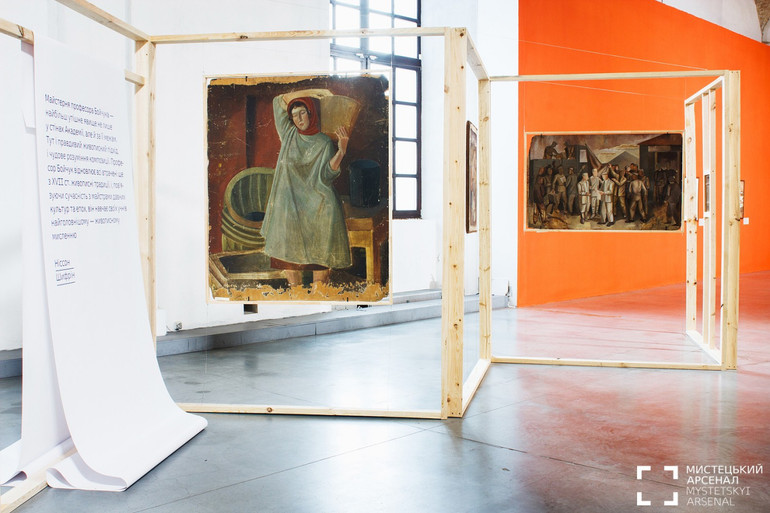
The exhibition “Boychukism. A project of great style”
Evgeny Nikiforov
Thanks to the Lviv artist Yaroslava Muzytsa, the most significant and unique part of Boichuk’s work is in the collections of the Andrey Sheptytskyi National Museum in Lviv and the Borys Woznytskyi Lviv National Art Gallery.
Literary critic and writer Marko-Robert Stech says that the legacy of the Boychukists gives space for thinking about modern problems, for example, “the issue of the government’s relationship to culture”. It remains to be attentive to one’s own culture, because, as Boychuk told his students in lectures: “The perfect work of art is not archeology, but living truth”.
[ad_2]
Original Source Link











